Class 12 Physics MCQ
1) A system containing two equal and opposite charges separated by a finite distance is called as:
- Electric flux
- Electric dipole
- Electric field
- None of the above
Answer: (b) Electric dipole
Explanation: The dipole moment has two charges with the separation distance between them. The two charges are +q and -q, while the separation distance is 2l. It means that the net charge on an electric dipole is 0.
2) Which of the following statements about the electric field lines is incorrect?
- Electrostatic field lines cannot intersect.
- Electrostatic field lines cannot form closed loops.
- Electrostatic field lines must be normal to the surface of the conductor.
- Electrostatic field lines cannot originate from the positive charge.
Answer: (d) Electrostatic field lines cannot originate from the positive charge.
Explanation: Electrostatic field lines can originate only from the positive charge and terminates at the negative charge. It cannot originate from the negative charge.
3) Which of the following physical quantity has S.I. unit J/C?
- Electric flux
- Dipole moment
- Electric Potential
- Electric field intensity
Answer: (c) Electric potential
Explanation: Electric potential is a scalar quantity, which is calculated as:
Electric potential = Work done/Charge
The unit of work done is Joule, and the charge of a conductor is Coulomb. Thus, the S.I. unit of the electric potential is:
Joule/Coulomb = J/C.
4) Find the charge and voltage across the capacitor C4 of the given below capacitance network.
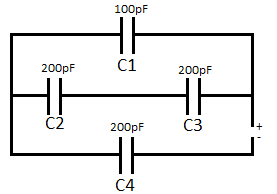
- 150V
- 200V
- 160V
- 60V
Answer: (a) 150V
Explanation:
Here, we will first solve the capacitance network to find the network’s equivalence capacitance.
Step 1: The two capacitors are connected in series. After solving, we get:
C = 1/200 + 1/200 = 100pF
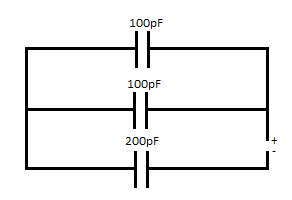
Step 2: The two capacitors of 100pF are now in parallel. The equivalent capacitance will be 200pF.
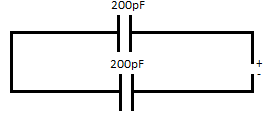
Step 3: The two capacitors are now in series. After solving we get:
C = 1/200 + 1/200 = 100pF
The equivalent circuit appears as:

Ceq = 100pF
Q = Ceq x V
Q=100×10-12×300=3×10-8
C4 = Q/C4
C4 = 150V
5) The flux of the electrostatic field through the closed spherical surface is found to be four times that through the closed spherical surface S. Find the magnitude of the charge Q. The three charges are q1 = 1Uc, q2 = -4uC, q3 = 8.84uC.
- 5.84uC
- 31.32uC
- 17.52uC
- 38.52uC
Answer: (c) 17.52uC
Explanation: Consider the below figure:
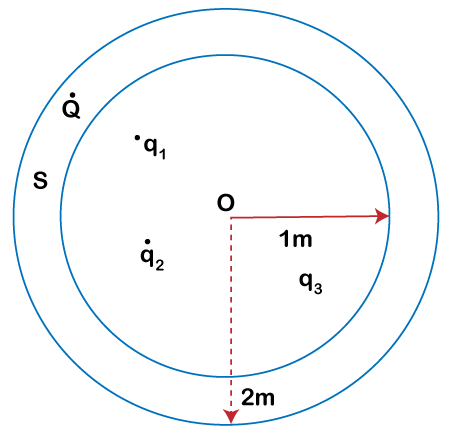
The flux through S’ = 4 x flux through S
By Gauss theorem,
Net flux through the surface is equal to:

Flux through S’ is equal to:

Flux through S is equal to:

Equating both equations, we get:

The value of charge Q is:
= 3 (1 – 4 +8.84)
= 17.52
6) What is the effect on the capacitance of a conductor when an earthed conductor is brought near it?
- Decreases
- Increases
- No effect
- Always decrease
Answer: (c) Increases
Explanation: The earth conductor has low electric potential due to its connection to the earth. It increases the capacitance of the conductor.
7) The fuse in electrical circuits has:
- Low resistivity, high melting point
- High resistivity, low melting point
- Low resistivity, low melting point
- High resistivity, high melting point
Answer: (b) High resistivity, low melting point
Explanation: During the high current, the fuse melts and breaks the circuit. It prevents the circuit from any damage. Thus, the fuse has a low melting point and high resistivity.
8) The Internal resistance of a cell depends on which of the following factors:
- Area of immersed part of electrodes
- Separation between electrodes
- Nature and concentration of an electrolyte
- None of the above
Answer: (d) None of the above
Explanation: Internal resistance of the cell is defined as the hindrance offered by the electrolyte of the cell to the flow of current. It depends on the area of the immersed part of the electrodes in the electrolyte solution, nature, and concentration of the electrolyte. It also depends on the distance between the two electrodes (anode and cathode) of a cell.
9) The path of electrons in the presence of an electric field is:
- Straight
- Curved
- Zigzag
- None of the above
Answer: (b) Curved
Explanation: The path of the electrons in the presence of an electric field is curved. But, in the absence of the electric field, the path of electrons is straight.
10) What is the resistance and tolerance value of a resistor with four colors red, orange, green, and silver marked on the it?
- 2.3MΩ±10%
- 2.3KΩ±10%
- 3.2MΩ±5%
- 3.2MΩ±10%
Answer: (a) 2.3MΩ±10%
Explanation: The above resistor has four color bands. The fourth color band is used to find the tolerance. The table is shown below:
| Color Name | Color | Digit | Multiplier | Tolerance |
|---|---|---|---|---|
| Black | 0 | 1 | – | |
| Brown | 1 | 10 | ±1% | |
| Red | 2 | 100 | ±2% | |
| Orange | 3 | 1000 | – | |
| Yellow | 4 | 10000 | – | |
| Green | 5 | 100000 | ±0.5% | |
| Blue | 6 | 1000000 | ±0.25% | |
| Violet | 7 | 10000000 | ±0.1% | |
| Grey | 8 | 100000000 | ±0.05% | |
| White | 9 | 1000000000 | – | |
| Gold | N/A | 0.1 | ±5% | |
| Silver | N/A | 0.01 | ±10% |
The corresponding digits for the first three colors are 2, 3, and 5. The fourth digit corresponds to the tolerance of 10%.
The format to find the resistance value is:
ab×Multiplier ±Tolerance
Where,
a, b, and n are the digits of the first three colors.
a = 2, b = 3, and n = 5
The resistance value of the given resistor is:
=2.3MΩ
The resistance value with the tolerance can be written as:
=2.3MΩ±10%
11) Three resistors of 2 Ohms, 3 Ohms, and 5 Ohms are connected in series with a 12V battery with no internal resistance. Find the total resistance of the combination and the potential difference across the resistor of 5 Ohms.
- 10 Ohms, 5V
- 10 Ohms, 3V
- 10 Ohms, 1.2V
- 10 Ohms, 6V
Answer: (d) 10 Ohms, 6V
Explanation:
In series combination, the resistance can be calculated as:
R = 2 + 3 + 5 = 10 Ohms
We know that the voltage is 12V. The current can be calculated as I = V/R
I = 12/10 = 1.2V
The potential difference across the resistor of 5 Ohms is:
V = IR3 = 1.2 x 5 = 6V
12) The charge carriers in a germanium semiconductor are:
- Electrons
- Holes
- Both (a) and (b)
- None of the above
Answer: (c) Both (a) and (b)
Explanation: A semiconductor consists of both positive charge carriers known as holes and negative charge carriers electrons. Both these charge carriers are responsible for the current generation in a semiconductor.
13) The ability of a material to allow the flow of magnetic lines of force through it is known as:
- Magnetic susceptibility
- Magnetic intensity
- Magnetizing field
- Magnetic permeability
Answer: (d) Magnetic susceptibility
Explanation: Magnetic susceptibility is defined as a substance’s ability to permit the passage of magnetic field lines through it.
14) Which of the following statement about the magnetic field lines is incorrect?
- Magnetic field lines never intersect.
- Magnetic field lines never emerge from a point.
- Magnetic field lines are completely straight.
- Magnetic field lines can meet to form closed loops.
Answer: (c) Magnetic field lines are completely straight
Explanation: Magnetic field lines can be curved but not straight.
15) The appropriate bandwidth used in telephonic communication is:
- 3000Hz
- 2800Hz
- 3100Hz
- None of the above
Answer: (b) 2800Hz
Explanation: The frequency range for speech signals lies between 300Hz and 3100Hz. Thus, the bandwidth of the speech signal or the telephonic communication can be calculated as:
3100Hz – 300Hz = 2800Hz
16) The electromagnetic waves can be transmitted through which of the following processes?
- Space wave propagation
- Ground wave propagation
- Sky wave propagation
- All of the above
Answer: (d) All of the above
Explanation: The electromagnetic waves through space can be transmitted using antennas and satellites. The three processes used for such transmission are space wave propagation, ground wave, and sky wave propagation.
17) Which one of the following is not a purpose of modulating a signal in transmission?
- Avoid mixing up of signals.
- Increase the size of the antenna.
- Reduce the size of the antenna.
- Reduce larger bandwidth.
Answer: (b) Increase the size of the antenna.
Explanation: The purpose of modulating a signal is to reduce the size of antenna. The reduced antenna size will improve its efficiency. It will also reduce the cost of the antenna.
18) The length of the dipole antenna for a carrier wave of the frequency of 6 x 10^8 Hz is:
- 0.25m
- 0.125m
- 0.5m
- 0.1025m
Answer: (b) 0.125
Explanation: The length of the dipole antenna is:
= ¼ (c/v)
=¼ (3 x 10^8)/ 6 x 10^8)
c is the speed of light, which is equal to 3 x 10^8 m/s.
v is the carrier wave frequency, which is given as 6 x 10^8 Hz.
= ¼(1/2)
= 1/8
=0.125m
19) Which of the following statement about Amplitude modulation is incorrect?
- It is noisy.
- It is expensive.
- It cannot be used for high-frequency carrier waves.
- Its production and reception are convenient.
Answer: (b) It is expensive
Explanation: Amplitude modulation is cheaper because it is simple to manufacture.
20) Acceptor level in the p-type semiconductor lies in:
- The top of the valence band
- Bottom of the conduction band
- Top of the conduction band
- None of the above
Answer: (a) the top of the valence band
Explanation: The majority of carriers in the p-type semiconductor are holes. It means that the p-type semiconductor is deficient in electrons. The movement of electrons is from one hole to another. Hence, the acceptor level lies on the top of the valence band.
21) Which of the following statement about LED (Light Emitting diode) is correct?
- Fast action
- Low operational voltage
- Short life span
- Both (a) and (b)
Answer: (d) Both (a) and (b)
Explanation: The Light Emitting diodes have low operational voltage, fast action, and longer life as compared to other light sources.
22) The device used in satellites to recharge their batteries is:
- Photodiode
- Solar cell
- LED
- Zener diode
Answer: (b) Solar cell
Explanation: The solar cell uses sunlight as the incident energy and gives rise to the photocurrent, which is used to recharge the batteries in satellites.
23) Two amplifiers are connected in series, one after the other. The voltage gain of both the amplifiers is 10 and 20. Calculate the output signal if the input signal is 0.01V?
- 2V
- 3V
- 1.5V
- 0.5V
Answer: (a) 2V
Explanation: Av = A1 x A2 = 10 x 20 = 200
Voltage gain = Output voltage/ Input signal voltage
Av = Vo/Vi
Vo = Av x Vi
Vo = 200 x 0.01
Vo = 2V
Thus, the output voltage is 2V.
24) The circuit shows the two inputs A and B inverted using the two NOT gates. Their output is again fed to the NOR gate. Find the output and identify the logic gate of the complete circuit?
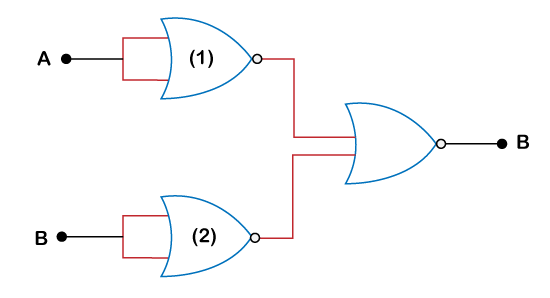
- NAND
- NOR
- OR
- AND
Answer: (d) AND
Explanation: Let consider the output of the two gates be Y1 and Y2. We can write it as:

The output of the two gates is again fed to the NOR gate. Let the output of the NOR gate be Y.
Y = (Y1 + Y2)’
We can write it as:

Hence, the logic gate output of the complete circuit is AND gate.
25) Rutherford’s model was unable to explain:
- Neutrality of an atom
- Photoelectric effect
- Stability of an atom
- Thermionic emissions
Answer: (c) Stability of an atom
Explanation: Rutherford model was unable to explain the stability of an atom.
26) Balmer series of the hydrogen emission spectrum lies in which region?
- Ultraviolet region
- Visible region
- Far infrared region
- None of the above
Answer: (b) visible region
Explanation: The short and longer wavelength of the Balmer series lies in the range of the visible region.
27) Which of the following statement about the Gamma rays is incorrect?
- Gamma rays travel in a vacuum with the speed of light.
- Gamma rays have the least penetration power.
- Gamma rays have the least ionizing power.
- Gamma rays are neutral.
Answer: (b) Gamma rays have the least penetration power.
Explanation: Gamma rays have the highest penetration power. It is because these rays do not possess any electric charge. The interaction of the gamma rays with the matter is not strong enough as compared to the charged particles. Hence, it has the highest penetration power.
28) What is the ratio of the radii of the two nuclei with the mass number 1 and 64?
- 1/4
- 1/64
- 1/16
- 1 /2
Answer: (a) 1/4
Explanation: Let the two radii be R1 and R2. We know,
R1/R2 = (A1/A2)^(1/3)
Where,
A1 and A2 are the mass number of the two nuclei.
R1/R2 = (1/64)^(1/3)
R1/R2 = 1/4
29) What is the impact on the neutron to proton ratio after the emission of the alpha particle?
- Decreases
- Constant
- Increases
- None of the above
Answer: (c) Increases
Explanation: After the emission, alpha particles pick up the electrons from the atoms. The emission also increases the atomic number. Hence, the neutron to proton ratio increases.
30) Heavy metals emit electrons during which incident radiations?
- Visible light
- Ultraviolet light
- Both (a) and (b)
- None of the above
Answer: (b) Ultraviolet radiations
Explanation: Ultraviolet radiations are high-frequency radiations. The electrons are emitted when the U.V. radiations fall on the surface of the metal. Visible light is suitable for alkali metals or sensitive metals.
31) What is the impact on the stopping potential with the increase of frequency?
- Decreases
- No impact
- Increases
- None of the above
Answer: (c) Increases
Explanation: The increase of frequency results in the rise of the maximum kinetic energy of the photoelectrons. It causes an increase in the stopping potential.
32) What is the stopping potential applied to a photocell if the maximum kinetic energy of a photoelectron is 6eV?
- 10V
- 2V
- 4V
- 5V
Answer: (d) 5V
Explanation: The stooping potential can be calculated as:
Ek = eVo = eVo = Vo = 5V
33) The red light cannot produce the electrons from a clean zinc metal surface because:
- The energy of a photon of red light is equal to the work function of the zinc.
- The energy of a photon of red light is greater than the work function of the zinc.
- The energy of a photon of red light is less than the work function of the zinc.
- None of the above
Answer: (c) Energy of photon of red light is less the work function of the zinc.
Explanation: The electrons are ejected from the metal surface if the incident light frequency is greater or equal to the threshold frequency. We can also say that the incident light’s energy should be greater than the metal’s work function.
Red light has low energy and low frequency. Hence, it cannot produce electrons from a clean zinc metal surface.
34) The electromagnetic spectrum with the wavelength of 0.1m or 10cm is:
- Visible light
- Shot radio waves
- Microwaves
- Gamma rays
Answer: (b) Short radio waves
Explanation: The range of the wavelength of the radio waves lies between 0.1m and 0.0001m. Hence, the electromagnetic spectrum with a wavelength of 0.1m is short radio waves.
35) Which among the following visible spectrum has the frequency of 620nm?
- Blue
- Orange
- Blue
- Indigo
Answer: (b) Orange
Explanation: The approximate range of orange color of the visible spectrum has a wavelength between 600nm and 650 nm. Hence, the wavelength of 620nm lies in the visible orange spectrum.
36) The origin of the displacement current:
- Arises due to the time variation of electric flux
- Arises due to motion of charge carriers
- Both (a) and (b)
- None of the above
Answer: (a) arises due to the time variation of electric flux
Explanation: The current flows due to the flow of electrons. The direction of the current is opposite to the flow of electrons. We can also say that the current direction is in the same direction as the flow of holes. The displacement current also exists when electrons flow at a uniform rate. It depends on the changing electric field. Hence, the origin of the displacement current arises due to the time variation of the electric flux.
37) The substances where the strong magnetism is generated in the same direction of the applied magnetic field are called:
- Paramagnetic substances
- Diamagnetic substances
- Ferromagnetic substances
- None of the above
Answer: (c) Ferromagnetic substances
Explanation: The ferromagnetic substances are strongly attracted to the magnet. Hence, the direction of such substances’ magnetism is in the same direction of the applied magnetic field.
38) A Galvanometer with a resistance G has the maximum safe potential difference, Vo. What resistance can be connected in series so that the Galvanometer may become a voltmeter of range nVo volts?
- nG
- (n – 1)G
- (n + 1)G
- nG/2
Answer: (b) (n – 1)G
Explanation: The current across the Galvanometer can be calculated as:
Ig = Vo/G
Where,
V = nVo
From the given relation, we can write the above equation as:
Ig = Vo/(R + G)
Vo/G = nVo(R + G)
R + G = nG
R = nG – G
R = G(n – 1)
39) The losses occurring in the core of the transformer that produces sound and vibrations is known as:
- Humming losses
- Hysteresis losses
- Iron losses
- Copper losses
Answer: (a) Humming losses
Explanation: When the alternating current flows across the transformer’s core, it starts producing humming sounds and vibrations. Such losses are termed humming losses.
40) What will be the change in the self-inductance of a coil if the number of turns in a solenoid is doubled?
- 2-times
- 4-times
- 8-times
- No effect
Answer: (b) 4- times
Explanation: Self-inductance of a solenoid is directly proportional to the square of the number of turns. Hence, if the number of turns in a solenoid is doubled, the self-inductance will be changed by 4 -times.
41) The phase difference between the voltages across the inductance and a capacitor in an alternating circuit is:
- 90 degrees
- 270 degrees
- 0 degrees
- 180 degrees
Answer: (d) 180 degrees
Explanation: The phase difference between the voltage across the inductance and a capacitor is 180 degrees.
42) The transformer is used to:
- Step up the ac voltage
- Step up the dc voltage
- Step down the ac voltage
- Both (a) and (c)
Answer: (d) Both (a) and (c)
Explanation: The transformer is only used to step up or step down the ac voltage. It cannot step up or step down the dc voltage. If the dc voltage is applied to the primary coil of a transformer, the current will remain same. It may produce no change in magnetic flux. It may produce no output current.
43) A 30W load is connected to the secondary winding of the transformer. The primary winding draws line current. If the current of 0.64 Amperes flows across the load, what is the current in the primary of the transformer?
- 0.32A
- 0.64A
- 4.7A
- 1.28A
Answer: (a) 0.32A
Explanation: Given: Power across the load PL = 30W, and IL = 0.64A
VL = PL/IL = 30/0.64 = 47V
The transformer given is a step-down. Hence, it has ½ input voltage.
Thus, the current across the primary winding Ip can be calculated as:
Ip = ½ IL
Ip = ½ 0.64 = 0.32A
44) An instrument that comprises of only a single convex lens is:
- Refracting telescope
- Compound telescope
- Simple telescope
- Reflecting telescope
Answer: (c) Simple telescope
Explanation: The simple telescope comprises a single convex lens. The compound and refracting telescope include two co-axial convex lenses. While reflecting the telescope, a concave mirror is used.
45) Which of the following is not a use of the Polaroid?
- Polaroid sheets present in sunglasses protect our eyes from the glass.
- Polaroid is used in 3D pictures.
- Partially polarized light beams show no variation in intensity.
- It is used in the analysis of the given light beam.
Answer: (c) Partially polarized light beams show no variation in intensity.
Explanation: The light beams that show no light intensity variations are known as unpolarized light beams.
46) The speed of sound in the medium depends on:
- Wavelength
- Nature
- Direction of propagation
- intensity
Answer: (a) Wavelength
Explanation: Speed of sound depends directly on the wavelength. It is independent of other factors, such as nature, the direction of propagation, and intensity.
47) Which light is deviated more by a prism?
- Red
- Blue
- Orange
- yellow
Answer: (b) Blue
Explanation: Blue deviates more than red, orange, and yellow. It is because the refractive index of blue is greater than these three colors. We can also say that the refractive index is inversely proportional to the wavelength. For example, violet has the shortest wavelength. Thus, it has the highest refractive index.
48) What is the refractive index of the medium with a polarizing angle of 60 degrees?
- 0.333
- 0.577
- 0.866
- 1.732
Answer: (d) 1.732
Explanation: The refractive index of a medium can be calculated as:
n = tan ip
Where, ip is the polarizing angle
n = tan 60 = 1.732
49) What is the focal length of the combination of the convex lens and the concave lens? The focal length of convex and the concave lens in contact is 30cm and 20cm, respectively.
- -50cm
- -60cm
- 10cm
- 60cm
Answer: (b) -60cm
Explanation: Let the focal length of the convex and the concave lens be F1 and F2.
F1 = 30cm
F2 = -20cm
The focal length F of the combination can be calculated as:
F = 1/F1 + 1 /F2
F = 1/30 + 1/(-20)
F = F1.F2/ (F1 + F2)
F = 30.(-20) / (30 – 20)
F = -600 / 10 = -60cm
50) What is the magnifying power of a small telescope that has an objective focal length of 144cm. The eye piece has the the focal length of 6.0cm.
- -150
- 24
- -24
- 138
Answer: (c) -24
Explanation: The magnifying power can be calculated as:
M = – fo / fe
Where,
fo and fe are the focal lengths of the objective lens and eye piece.
M = – 144/6.0 = -24
